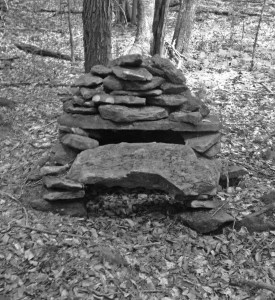It’s Only Natural—November 2015
Abandoned Charcoal Hearths Affect Today’s Forest Ecology
Hans M. Carlson
Recently, we got our first dusting of snow. When it’s not enough to cover the ground completely, the darker fallen leaves poke up through the veil of white, and small contours on the ground appear. The contrast highlights slight topographical variations, particularly with the lower angle of the autumn sun helping to differentiate slope and flat. This is a great time to go looking for the hundreds of colliers’ hearths scattered throughout the local woods.
In Great Mountain Forest, there are several hundred of these level circular areas, usually 25 to 30-feet in diameter, where colliers smoldered charcoal. Generally, they were built on gentle slopes where the excavated uphill section could be used to fill in below. This was hard work, and colliers used their hearths multiple times. Because of this repeated use, you can almost always find accumulated residual charcoal around the edges if you dig into the humus and leaf litter.
Colliers burned during the summer, piling four-foot billets of winter-cut hardwood into a kind of beehive oven, around a central support called the “Fagan pole.” Flues were built into the pile, which was then covered in leaves and soil. Opening and closing these flues regulated the smoldering process. The colliers’ trade was not only the hard work of building hearths and cutting wood, but also the art of regulation and watchfulness. Only a carefully tended hearth would produce pure crystallized carbon charcoal, free of water, gasses and resin—usually in about two weeks.
Colliers would generally build three or more hearths close together, and then construct a small hut nearby where they could keep constant watch. These huts were little more than holes dug in the ground covered by bent branches and bark, though some had rough fireplaces for heat.
Fireplaces and hearths are monuments to another age, static in time and relatively unchanged since being abandoned a century ago, but the land use they memorialize is one of the single most important factors in understanding contemporary forest ecology. Because the effects of industrial charcoal making altered forest composition in ways that will be readable on the land for hundreds of years, these changes are not static in time, and continue to inform our understanding of the forest in which we live.
The most obvious result of charcoaling was deforestation. Approximately two acres (30 to 50 cords of wood) were needed for each burn and yielded about 660 bushels of charcoal. It took 250 bushels to make a ton of iron, so with scores of local furnaces operating, it didn’t take long to work through the original forest.
To some degree, deforestation worked to the colliers’ advantage, as wood over six-inches in diameter had to be split, so the original trees involved a great deal more work than the smaller ones that regrew. Typically trees down to three inches could be used, so 20 to 30-year-old stands with high stem density were ideal. This young growth was cut and recut throughout the nineteenth century, though in the end colliers overtaxed the forest’s capacity to regenerate.
Of course, the forest did regrow, but charcoaling altered forest composition in favor of species like oak, which like a lot of disturbance and sun to regrow. It also created a legacy of even-aged stands, which though regrown, are not as biodiverse or as resilient as more mature forests with wider age ranges of trees.
Studies also suggest a variety of micro-changes to soil chemistry due to a century of charcoaling. Hearth sites have elevated pH, as well as altered capacity for holding and exchanging nutrients like calcium, magnesium and potassium relative to surrounding soils. Hearth soils thus show reduced vigor, seen in the slow and poor growth of vegetation on them. This relative barrenness is another clue to finding hearths, which quite often have a lone tree growing in the center, where the soil was less altered thanks to the presence of the Fagan pole. In all these ways, the work carried on here 150 years ago defines the present, even in a quiet, snowy, wintry wood.
Photo by Jody Bronson.

